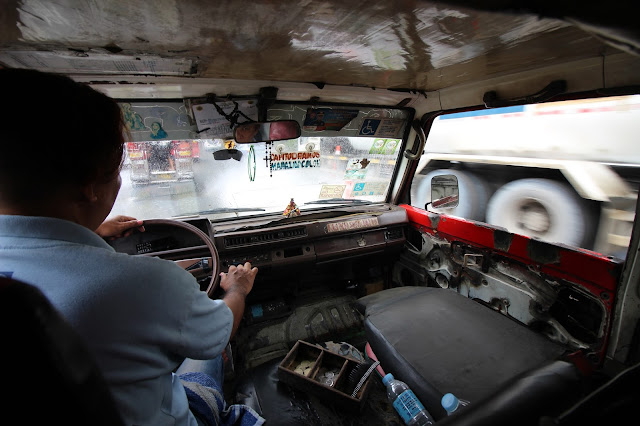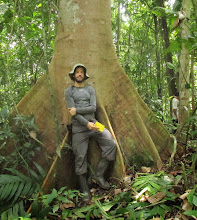 |
| Non-native mahogany trees forms the Manmade forest of Bohol, the Philippines |
In most tropical countries, you can discover
dazzling rainforests home to monkeys, colourful bird life, and legions of
unseen howling insects. But while In the Philippines, finding wild natural
forests proved challenging for us. Across the archipelago nation, only about 3%of primary forests now remain and the forest cover that is left (about 15% ofthe country) is secondary forests, which include degraded forests, young
forests from slash and burn (i.e. ‘swidden’) agriculture, and timber
plantations. These types of forests, which have been shaped by human culture,
economy and historical activities, are increasingly common worldwide.
While these forests are not pristine, they are
anthropologically very interesting, and many researchers examine them as ‘cultural
forests.’ You could learn something about any forest type you know by examining the
role of human culture and enterprise in shaping it. There are groves around
my hometown of Vancouver, BC, touched long ago by aboriginal forestry or
recovering from industrial logging. The famous Black Forest of Germany is
heavily shaped by historical forest use. Author Charles Mann in his book 1491, reveals that even remote swaths of the Amazon were once cultivated for fruit trees
by indigenous people millennia ago, shaping the forests seen today.
The extensiveness of our meddling with forests
seems rather disappointing at first, but there are lessons to glean from accepting
this reality. In many
forests, past human activity may better explain the height, species, and age of
trees than the depth and type of soil that the trees grow on. For example, a recent study from Taiwanese forests convincingly showed that we can better map and classify forest types by factoring in past human uses. Academics increasingly
reject the notion that man must be viewed as separate from nature.
Even conservation organizations are moving away from the ‘fortress nature’
strategy to conserve nature (where people are kept out). The question of what
this reality meant for how we perceive our relationship with forests was on my
mind as I traveled overland towards the so-called ‘Manmade forest,’ of Bohol
Island, the Philippines.
 |
| Lomboc River, Bohol, seen on route to the Manmade Forest |
The main question on my mind as a I pinned the
throttle to round a sharp corner on our rented scooter was how has the
so-called 'Manmade forests' at Bohol, the Philippines, become a well-known
attraction? "Visit the Manmade forest - one of man’s great
creations!!” was the sentiment I read.
The Manmade Forest of Bohol is truly no more than a timber plantation, an area planted with trees to procure wood and wood products. So it seemed odd based on my forest ecology background that a timber plantation was perceived so positively in a country now lacking natural forest, and that is has emerged as a popular tourist destination.
The Manmade Forest of Bohol is truly no more than a timber plantation, an area planted with trees to procure wood and wood products. So it seemed odd based on my forest ecology background that a timber plantation was perceived so positively in a country now lacking natural forest, and that is has emerged as a popular tourist destination.
Let me explain my suspicion by first stressing
that not all forests are created equally. Humans plant, engineer, and tend
forests on a massive scale, mostly in the form of timber plantations.
Incredibly, these altered forests, according to United Nations FAO statistics,
now spread across 67% of the world's forests. Relatively few primary or old
growth forests remain, which is very troubling for the critters that depend on
them - 50% of terrestrial biodiversity is in forests. It’s also concerning for
people, which cherish these places for their intrinsic and spiritual values.
Degradation of forests is a serious global problem.
Extending into some of the world's deepest wildernesses is a plague of forest
destruction - the cutting of natural forests and converting them to timber
plantations - which homogenizes the world’s forests into cornfield-like
plantations composed of a few species of tree. Most timber plantations have trees
all the same age and size planted row by row. They lack big trees, verdant
understories, and one patch of trees is practically identical to the next.
 |
| Successful forest plantation of Douglas-fir in BC, Canada |
To be cynical, I’ll add that the term 'Manmade
forests' might seem a bit arrogant, doesn’t it? After all, nature does most of
the work. After planting the seed, the forest largely organizes itself under
the energizing power of the sun (thanks to photosynthesis) and with the help of
other natural growth processes such as decomposition, nutrient cycling, and gas
exchange the trees grow into a forest. But, contrary to
these ideals, we must face that growing a forest is hard work and many things can
interfere with our best intentions. Major challenges for reforestation in the Philippines have been a lack of vigorous and appropriate genetic seedling stock,
prescriptions for how to space the trees, and resources to tend weeds,
fertilize, and manage pests to ensure the seedlings can establish. In these cases a
less impressive forest or no forest at all will result, which has major
implications for a developing country that needs wood for building
and heating, and other forest products important to their economy and culture.
 |
| Another example of a very old timber plantation. This one at FRIM near Kuala Lumpur, Malaysia |
Planted timber plantations are extremely good at one thing in particular:
producing lots of wood or other desired forest products. Forests are cultivated
in the tropics to provide a range of renewable resources, including rubber,
wood, fruits and nuts, coffee, and fiber products. While some secondary forests
in the tropics are massive industrial plantations that are truly detrimental to biodiversity, others are small
locally-owned patches among a broader ecological landscape and these are critical to people’s livelihoods. The Philippines is
desperate for effective reforestation. While forest products once supported 12%
of GDP in the Philippines (at its peak in the 1970s) the harvest of forests was
so unsustainable for a few decades that forests became so depleted that timber
exports are now banned as the country relies on imports to meet their domestic
timber needs.
 |
| A plantation of Nipa palm (Nypa fruticans), which provides a useful fiber, food, and is used in an alcoholic beverage |
Sometimes secondary forests are very nice, cool
places to visit, too. Admittedly, the Manmade forest is an aesthetically
pleasing and interesting grove to visit as it stands out from the rest of the
forests around it. The forest is mahogany, a valuable timber species imported
from South America. The Manmade forest is old and uniformly tall. The 60-year
old trees are mature and tall enough to form a prominent arch over the roadway,
as one source states, like “sentinels guarding the road.” This forest has been
ready for harvest probably for more than a decade, but I doubt they will cut it
down now since it’s become an iconic tourist attraction. It’s worth far more
left standing.
 |
| A secondary forest heavily infused with coconut trees. Moalboal, Cebu, the Philippines |
The man-made forest of Bohol now supports a major eco-adventure park and is a primary tourist attraction on the island. It somehow drew us in. I must applaud the promoters here because they have seen this forests for much more than just the timber in its trees. To get to the Manmade forest, we rented a motorbike in Taglibbaran City for $15. As we navigated the steep mountainous terrain, turn by turn, we entered its fresh shade through the open air. A major reason to visit this forests is its location along the road towards a striking limestone formation known as the Chocolate Hills.
 | |
|
Other examples of planted forest with high cultural value include those in
botanical gardens, arboretums, city parks, and even old streets trees planted
long ago along an old country road.
I think there is a rather pragmatic lesson I gained in my reflections on Bohol's Manmade forest. While the ongoing cutting of earth's increasingly rare old-growth forests is deplorable in most cases in an ever changing world we must also look to our recovering forests in earnest and be creative and in how we can adapt and build cultural appreciation around them.
I think there is a rather pragmatic lesson I gained in my reflections on Bohol's Manmade forest. While the ongoing cutting of earth's increasingly rare old-growth forests is deplorable in most cases in an ever changing world we must also look to our recovering forests in earnest and be creative and in how we can adapt and build cultural appreciation around them.








